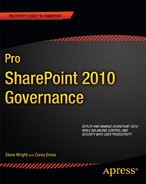Contents
Chapter 1: A SharePoint Manifesto
Finding What You Need in This Book
Part I: Establishing Governance
Part II: Information Technology Governance
Part III: Information Management
Part IV: Application Management
Chapter 2: SharePoint Governance Overview
What Will You Learn in This Chapter?
Ongoing Maintenance and Planning
Chapter 3: Governance Planning
What Will You Learn in This Chapter?
Establishing a Governance Committee
Set the Objectives for Governance
Assign Roles and Responsibilities
Develop Governance Planning Documents
Chapter 4: Implementing Services
What Will You Learn in This Chapter?
Chapter 5: User Training and Adoption
What Will You Learn in This Chapter?
Provide Incentives and Recognition
Establish and Train a Portal Help Desk
Provide Contact Information for Content
Create Online Self-Help Communities for Users
Actively Solicit User Feedback
Training and Adoption Resources
What Will You Learn in This Chapter?
Types of SharePoint Content Containers
Managing Different Types of Sites
Planning the Content Lifecycle
Controlling Content with SharePoint Features
Information Management Policies
Chapter 7: Managing the Server Farm
What Will You Learn in This Chapter?
Introduction to Farm Management
Backup and Restore Configurations and Content
Chapter 8: Managing Operations
What Will You Learn in This Chapter?
SharePoint Farm Configurations
SharePoint 2010 Unified Logging Service
Usage Data and Health Data Collection
Default SharePoint Permission Levels
Determine Need for Custom Permission Levels or Groups
Chapter 9: Information Architecture Overview
What Will You Learn in This Chapter?
SharePoint Hierarchy Considerations
Automating Information Lifecycles
Chapter 10: Information Delivery
What Will You Learn in This Chapter?
Types of Information Within SharePoint
Customize Display of Information from Web Part
Possible Approaches to Limit Outdated Content
How to Deliver Information Within SharePoint
Tools to Define Information Delivery
Delivery of Information Through Search
Chapter 11: Branding the User Interface
What Will You Learn in This Chapter?
SharePoint Multilingual Support
SharePoint Publishing and Branding
Chapter 12: Customization and Tools
What Will You Learn in This Chapter?
Introduction to Application Management
Chapter 13: Packaging Solutions
What Will You Learn in This Chapter?
Understanding Deployment Environments
Adding a Solution to the Farm Store
Deploying a Solution to the Farm
Deploying a Solution to the Solution Gallery
Activating a Sandboxed Solution
Understanding the SharePoint Sandbox
Resource Monitoring and Quotas
Customizing a Solution Package
When and Why to Play in Your Own Sandbox
Chapter 14: Application Lifecycle Management
What Will You Learn in This Chapter?
Site Provisioning and Management
Business Connectivity Services
Appendix B: The Governance Plan
